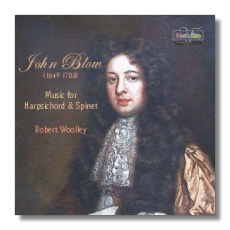
The Internet's Premier Classical Music Source
Related Links
- Latest Reviews
- More Reviews
-
By Composer
-
Collections
DVD & Blu-ray
Books
Concert Reviews
Articles/Interviews
Software
Audio
Search Amazon
Recommended Links
Site News
 CD Review
CD Review
John Blow

Music for Harpsichord and Spinet
- Prelude for Keyboard in G Major
- Ground in G minor
- A Choice Collection of Lessons:
- Suite #1 in D minor
- Suite #4 in C Major
- Chaconne in F Major
- Chaconne in G Major
- Mortlack's Ground
Robert Woolley, harpsichord and spinet
Meridian CDE84464 ADD 75:36
Recorded in analogue sound (very fetchingly) in 1981 and 1982, this collection of various keyboard works by John Blow (1649-1708) is welcome in 2005. Blow was Henry Purcell's mentor, and so it is difficult to overestimate the impact that he had on the evolution of English music right up to the present time. Purcell's keyboard music is overshadowed by his works for the theater and the church. In contrast, Blow composed a great deal of keyboard music of considerable importance, although not much of it has been published until recently. We owe it to musicians such as Robert Woolley that this music is being made available to us once more.
There are several genres of music on this CD. First, there are two brief and independent preludes, whose function is likely to have been to train the musician as well as to entertain the listener. Various grounds and chaconnes (here spelled "chacones") make use of the repeated bass lines characteristic of these genres, although Blow treats this so-called "ground bass" device with some freedom, particularly in the chacones – which are, after all, dance music. And then there are the multi-movement suites, or "setts." Blow composed around a dozen of these. Bach's suites often had six or seven movements, and suites by French composers could have even more. Blow limited himself to four or five movements in his suites, although the movement names (almand, saraband, corant, gavotte, etc.) will be familiar from Bach and the French models. Finally, there are individual pieces in various categories, such as music that might have been used in theatrical settings – "Mr. Mountfort's Delight" is an example of this, William Mountfort, being a prominent entertainer from the Restoration period.
Woolley plays two instruments on this recording, a Bentside spinet built in 1689, and a harpsichord by an unknown maker, built in 1623. Woolley's reasons for using one instrument or another in each of the works is not explained, but it might have to do with the fact that the harpsichord has a five-octave range, while the spinet has a range of only four. At any rate, Woolley's choice of instruments is effective, and the attractiveness of this CD is enhanced by the variety in timbres. Woolley is sensitive to the music's beautiful gravity, as well as to Blow's fantasy and creativity. This is an excellent collection, and it will enrich the hours of any intelligent listener.
Copyright © 2005, Raymond Tuttle


















